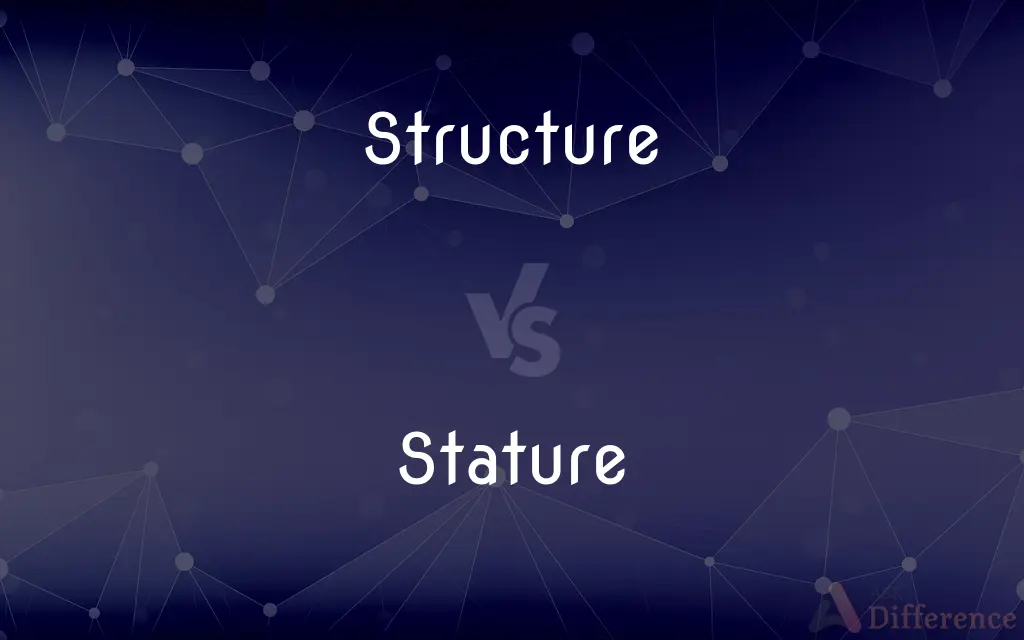Structure vs. Stature — What's the Difference?
By Urooj Arif & Fiza Rafique — Updated on March 1, 2024
Structure refers to the arrangement or organization of parts to form a whole, applicable to physical, social, or abstract entities, while stature pertains to the height or physical build of a person or the reputation and standing of an individual.

Difference Between Structure and Stature
Table of Contents
ADVERTISEMENT
Key Differences
Structure is a term that encompasses the physical, social, or conceptual organization of components within a system. Stature, on the other hand, can have both a literal and metaphorical application. Literally, it denotes the physical height or size of a person. Metaphorically, it signifies the level of respect, reputation, or importance an individual or organization commands within a particular context.
Structure refers to the construction and design of buildings; in biology, the arrangement of tissues in an organism; and in social sciences, the organization of relationships within societies. For example, the structure of a corporation might include its hierarchy of employees and departments. An individual's professional stature is often built over years through achievements and recognition in their field.
The key distinction between the two lies in their application and significance. Structure is fundamentally about the arrangement and organization of parts, crucial for understanding the functionality and operation of various systems. Stature is concerned with height or reputation, reflecting physical characteristics or the perceived value and respect an entity holds.
Structures are integral to the stability and functionality of both physical objects and societal organizations. They provide the framework within which systems operate. Stature, especially in its metaphorical sense, evolves over time and is reflective of achievements, contributions, and recognition.
Understanding the structure of something can provide insights into its design, functionality, and potential weaknesses. Recognizing the stature of a person or organization helps in assessing their influence, credibility, and role within a community or industry.
ADVERTISEMENT
Both structure and stature play significant roles in their respective contexts. While the former is essential for the physical and organizational coherence of entities, the latter is key to understanding social dynamics and the impact of individuals or organizations on their surroundings.
Comparison Chart
Definition
The arrangement or organization of parts within a system.
The height of an individual or the reputation of an entity.
Application
Physical buildings, biological organisms, social organizations
Physical height, social standing, professional reputation
Significance
Determines functionality, stability, and design.
Indicates physical characteristics or societal respect.
Example
The structure of a DNA molecule.
An individual's stature in the scientific community.
Focus
Organization and arrangement.
Height and reputation.
Compare with Definitions
Structure
Organization of a company's departments.
The corporate structure defined clear roles and hierarchies.
Stature
The respect accorded to a professional.
Her stature as a novelist grew with each publication.
Structure
Composition of a chemical compound.
The molecular structure of water is H2O.
Stature
Recognition of an artist's work.
The painter's stature increased after the exhibition.
Structure
Framework of a legal system.
The country's legal structure was based on civil law.
Stature
An individual's height.
The basketball player's stature was an advantage on the court.
Structure
The architectural design of a building.
The structure of the skyscraper included a steel frame.
Stature
The standing of a company in the market.
The startup's stature in the tech industry rose rapidly.
Structure
A structure is an arrangement and organization of interrelated elements in a material object or system, or the object or system so organized. Material structures include man-made objects such as buildings and machines and natural objects such as biological organisms, minerals and chemicals.
Stature
The influence of a historical figure.
The president's stature is evident in the impact of his policies.
Structure
Layout of a computer network.
The IT department updated the network structure to improve security.
Stature
The natural height of a human or animal in an upright position.
Structure
The arrangement of and relations between the parts or elements of something complex
The two sentences have equivalent structures
The company's weakness is the inflexibility of its management structure
Stature
An achieved level; status.
Structure
A building or other object constructed from several parts
The station is a magnificent structure and should not be demolished
Stature
A person or animal's natural height when standing upright.
Structure
Construct or arrange according to a plan; give a pattern or organization to
Services must be structured so as to avoid pitfalls
Stature
The natural height of an animal body; - generally used of the human body.
Foreign men of mighty stature came.
Structure
Something made up of a number of parts that are held or put together in a particular way
Hierarchical social structure.
Structure
The underlying shape of a solid.
He studied the structure of her face.
Structure
The overall form or organization of something.
The structure of a sentence.
The structure of the society was still a mystery.
Structure
The complex composition of knowledge as elements and their combinations;
His lectures have no structure
Structure
A particular complex anatomical structure;
He has good bone structure
Structure
The people in a society considered as a system organized by a characteristic pattern of relationships;
The social organization of England and America is very different
Sociologists have studied the changing structure of the family
Common Curiosities
What does structure refer to in social sciences?
In social sciences, structure refers to the organization and relationship of elements within societies, such as social hierarchies and institutions.
Can structure apply to abstract concepts?
Yes, structure can also describe the organization of abstract concepts, such as the structure of arguments in logic or the structure of a software program.
Is the structure of an entity static?
No, the structure of an entity, whether physical or organizational, can evolve over time due to growth, changes in design, or reorganization.
What affects an individual's or entity's stature?
An individual's or entity's stature is influenced by achievements, contributions to their field, recognition by peers, and overall impact on society.
How is stature measured?
Physically, stature is measured in units of length, typically centimeters or feet and inches. Metaphorically, it's assessed through achievements, recognition, and respect within a community.
How do structure and stature contribute to success?
A well-organized structure is essential for efficiency and stability, while high stature can open doors to opportunities and collaborations, contributing to overall success.
Can a person's physical stature affect their social stature?
While physical stature and social stature are distinct, perceptions of physical height can sometimes influence social interactions and opportunities, albeit social stature is more significantly shaped by actions and achievements.
Does every organization have a formal structure?
Most organizations have a formal structure outlined through organizational charts and policies, but informal structures based on relationships and influence also exist.
How is stature recognized in academic fields?
In academic fields, stature is recognized through publications, citations, awards, and contributions to the body of knowledge.
What is the importance of understanding structure in engineering?
In engineering, understanding structure is crucial for designing buildings, bridges, and other constructions that are safe, efficient, and fit for purpose.
Share Your Discovery

Previous Comparison
Eager vs. Yearning
Next Comparison
Whoo vs. WooAuthor Spotlight
Written by
Urooj ArifUrooj is a skilled content writer at Ask Difference, known for her exceptional ability to simplify complex topics into engaging and informative content. With a passion for research and a flair for clear, concise writing, she consistently delivers articles that resonate with our diverse audience.
Co-written by
Fiza RafiqueFiza Rafique is a skilled content writer at AskDifference.com, where she meticulously refines and enhances written pieces. Drawing from her vast editorial expertise, Fiza ensures clarity, accuracy, and precision in every article. Passionate about language, she continually seeks to elevate the quality of content for readers worldwide.
















































